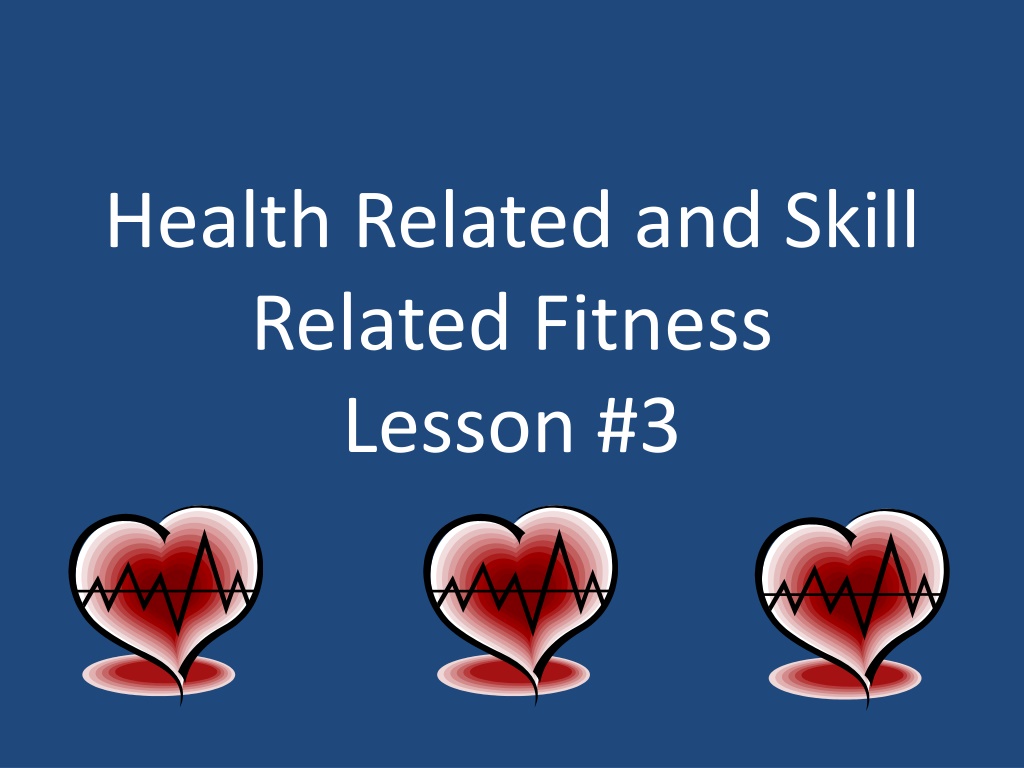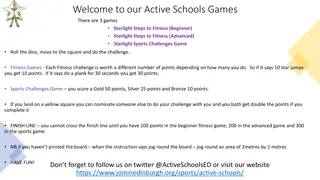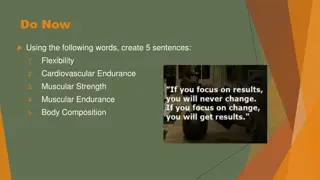Understanding Fitness: Health Related and Skill Related Components Explained
Fitness is the ability of your body to work efficiently and effectively. Health related fitness includes cardiovascular endurance, strength, muscular endurance, flexibility, and body composition, while skill related fitness impacts sports performance. Maintaining a balance between the two categories is essential for overall well-being.
Download Presentation

Please find below an Image/Link to download the presentation.
The content on the website is provided AS IS for your information and personal use only. It may not be sold, licensed, or shared on other websites without obtaining consent from the author. Download presentation by click this link. If you encounter any issues during the download, it is possible that the publisher has removed the file from their server.
E N D
Presentation Transcript
Health Related and Skill Related Fitness Lesson #3
WHAT IS FITNESS? PHYSICAL FITNESS DEFINITON: Ability of the whole body (muscles, skeleton, heart & other body parts) to do work together efficiently Ability to do the most work with the least amount of effort 2 CATEGORIES HEALTH RELATED FITNESS SKILL RELATED FITNESS
HEALTH RELATED FITNESS To be healthy you should have at least some of each of the heath related components of fitness. If you do, you are less likely to develop other health problems related to a lack of exercise. (ex. heart disease, high blood pressure, back pain, obesity).
CARDIOVASCULAR ENDURANCE The ability to exercise the entire body for long periods of time Requires a strong heart, healthy lungs & clear blood vessels to supply the body with O2.
STRENGTH Amount of force you put forth with your muscles Can be measured by how much weight you can lift Advantages: fewer problems with backaches, carry out daily tasks efficiently
MUSCULAR ENDURANCE Ability to use the muscles many times without getting tired Advantages: better posture, fewer back problems, less likely to tire easily
FLEXIBILITY Ability to use your joints fully Muscles are long enough & the joints are free enough to allow movement Advantages: fewer sore and injured muscles, less chance of injuries
BODY COMPOSITION Percentage of body weight that is fat compared to other body tissues, such as bone and muscle High % of body fat = increased rates of illness and death
SKILL RELATED FITNESS If you are good at these skill related components of fitness, you are likely to be good at sports and games. Different sports require different components but most require more than just one of these areas. Some people have more natural ability in these areas but no matter where your strengths lie, you can always find some type of physical activity that you can enjoy.
AGILITY Ability to change the position of your body quickly & to control the movement of your whole body
BALANCE Ability to keep an upright posture while standing still or moving
COORDINATION Ability to use your senses, such as your eyes, together with your body parts, such as your arms Using 2 or more body parts together Good hand-eye or foot-eye coordination
POWER Ability to do strength performances quickly Involves both strength & speed
REACTION TIME Amount of time it takes to get moving once you see the need to move Make fast starts in track & swimming
SPEED Ability to perform a movement or cover a distance in a short period of time Leg speed = run fast over short distance Arm speed = throw fast or hit fast balls
IMPORTANCE It is important to note that good health does not come from being good in skill related components of fitness. Good health comes from participating in activities designed to improve your HEALTH RELATED FITNESS.
MOST IMPORTANT OF ALL COMPONENTS LISTED: CARDIOVASCULAR ENDURANCE
HOW TO DEVELOP YOUR CARDIOVASCULAR ENDURANCE Complete the CARDIOVASCULAR ENDURANCE worksheet to develop a better understanding about how to keep your heart happy, healthy, and fit
CARDIOVASCULAR TRAINING F.I.T.T. FORMULA FREQUENCY INTENSITY TIME/DURATION TYPE
FITT Principle Review What does each letter in FITT stand for? How OFTEN should you exercise? Frequency How HARD should you exercise? Intensity How LONG should you exercise for? Time What KIND of exercise should you do? Type
FREQUENCY How often to exercise Minimum 3 X s weekly Maximum 4-5 X s weekly
INTENSITY How hard to exercise Minimum heart rate above the lower limit of your training range Maximum heart rate below the upper limit of training range
TYPE The kind of exercise you choose to participate in Minimum low impact exercise walking Maximum high impact exercise - running
TIME OR DURATION How long to exercise Minimum 15 minutes Maximum 30 minutes
TARGET HEART RATE Your target heart rate is the threshold of training you must work out at for the heart to receive any benefits Exercise within your target heart rate for 15- 30 minutes to get maximum benefits of exercise
Lets get FITT Grab a heart rate monitor We are going to do some cardiovascular exercise (T) for 15 minutes (T), within your target heart range (I). We will stop every 3 minutes to get a heart rate reading This is something that you should aim to do 3- 5 times per week (F)!
Reversing the Effects of Heart Disease























